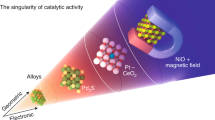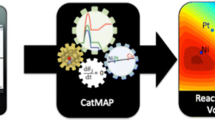Abstract
Volcano plots and activity maps are powerful tools for studying homogeneous catalysis. Once constructed, they can be used to estimate and predict the performance of a catalyst from one or more descriptor variables. The relevance and utility of these tools has been demonstrated in several areas of catalysis, with recent applications to homogeneous catalysts having been pioneered by our research group. Both volcano plots and activity maps are built from linear free energy scaling relationships that connect the value of a descriptor variable(s) with the relative energies of other catalytic cycle intermediates/transition states. These relationships must be both constructed and postprocessed appropriately to obtain the resulting plots/maps; this process requires careful execution to obtain meaningful results. In this protocol, we provide a step-by-step guide to building volcano plots and activity maps using curated reaction profile data. The reaction profile data are obtained using density functional theory computations to model the catalytic cycle. In addition, we provide volcanic, a Python code that automates the steps of the process following data acquisition. Unlike the computation of individual reaction energy profiles, our tools lead to a holistic view of homogeneous catalyst performance that can be broadly applied for both explanatory and screening purposes.





Similar content being viewed by others
Data availability
All data to reproduce all the figures of this work are available at https://github.com/lcmd-epfl/volcanic, as well as instructions to generate such plots using the volcanic package.
Code availability
The volcanic package is available at https://github.com/lcmd-epfl/volcanic. Supplementary Methods detail the manual procedure for the application highlighted in Fig. 4.
References
Nørskov, J. K. et al. The nature of the active site in heterogeneous metal catalysis. Chem. Soc. Rev. 37, 2163 (2008).
Kulkarni, A., Siahrostami, S., Patel, A. & Nørskov, J. K. Understanding catalytic activity trends in the oxygen reduction reaction. Chem. Rev. 118, 2302–2312 (2018).
Wodrich, M. D., Sawatlon, B., Busch, M. & Corminboeuf, C. The genesis of molecular volcano plots. Acc. Chem. Res. 54, 1107–1117 (2021).
Sabatier, P. Hydrogénations et déshydrogénations par catalyse. Ber. Dtsch. Chem. Ges. 44, 1984–2001 (1911).
Calle-Vallejo, F., Martı́nez, J. I., Garcı́a-Lastra, J. M., Rossmeisl, J. & Koper, M. T. M. Physical and chemical nature of the scaling relations between adsorption energies of atoms on metal surfaces. Phys. Rev. Lett. 108, 116103 (2012).
Busch, M., Wodrich, M. D. & Corminboeuf, C. Linear scaling relationships and volcano plots in homogeneous catalysis—revisiting the Suzuki reaction. Chem. Sci. 6, 6754–6761 (2015).
Bligaard, T. et al. The Brønsted–Evans–Polanyi relation and the volcano curve in heterogeneous catalysis. J. Catal. 224, 206–217 (2004).
Gerischer, H. Mechanismus der elektrolytischen Wasserstoffabscheidung und Adsorptionsenergie von atomarem Wasserstoff. Bull. Soc. Chim. Belg. 67, 506–527 (2010).
Parsons, R. The rate of electrolytic hydrogen evolution and the heat of adsorption of hydrogen. Trans. Faraday Soc. 54, 1053 (1958).
Nørskov, J. K., Bligaard, T., Rossmeisl, J. & Christensen, C. H. Towards the computational design of solid catalysts. Nat. Chem. 1, 37–46 (2009).
Man, I. C. et al. Universality in oxygen evolution electrocatalysis on oxide surfaces. ChemCatChem 3, 1159–1165 (2011).
Medford, A. J. et al. From the Sabatier principle to a predictive theory of transition-metal heterogeneous catalysis. J. Catal. 328, 36–42 (2015).
Medford, A. J. et al. Activity and selectivity trends in synthesis gas conversion to higher alcohols. Top. Catal. 57, 135–142 (2014).
Andersen, M., Medford, A. J., Nørskov, J. K. & Reuter, K. Analyzing the case for bifunctional catalysis. Angew. Chem. Int. Ed. 55, 5210–5214 (2016).
Busch, M. et al. Beyond the top of the volcano? A unified approach to electrocatalytic oxygen reduction and oxygen evolution. Nano Energy 29, 126–135 (2016).
Exner, K. S. Recent advancements towards closing the gap between electrocatalysis and battery science communities: the computational lithium electrode and activity–stability volcano plots. ChemSusChem 12, 2330–2344 (2019).
Anand, M., Rohr, B., Statt, M. J. & Nørskov, J. K. Scaling relationships and volcano plots in homogeneous catalysis. J. Phys. Chem. Lett. 11, 8518–8526 (2020).
Swiegers, G. Mechanical catalysis: Methods of enzymatic, homogeneous, and heterogeneous catalysis. (John Wiley, 2008).
Sues, P. E., Lough, A. J. & Morris, R. H. Stereoelectronic factors in iron catalysis: synthesis and characterization of aryl-substituted iron(II) carbonyl pnnp complexes and their use in the asymmetric transfer hydrogenation of ketones. Organometallics 30, 4418–4431 (2011).
Meek, S. J., Pitman, C. L. & Miller, A. J. M. Deducing reaction mechanism: a guide for students, researchers, and instructors. J. Chem. Educ. 2, 275–286 (2016).
Fey, N. & Lynam, J. M. Computational mechanistic study in organometallic catalysis: why prediction is still a challenge. WIREs Comput. Mol. Sci. 12, e1590 (2021).
Harvey, J. N., Himo, F., Maseras, F. & Perrin, L. Scope and challenge of computational methods for studying mechanism and reactivity in homogeneous catalysis. ACS Catal. 9, 6803–6813 (2019).
Ryu, H. et al. Pitfalls in computational modeling of chemical reactions and how to avoid them. Organometallics 37, 3228–3239 (2018).
Wodrich, M. D., Sawatlon, B., Busch, M. & Corminboeuf, C. On the generality of molecular volcano plots. ChemCatChem 10, 1586–1591 (2018).
Wodrich, M. D., Busch, M. & Corminboeuf, C. Accessing and predicting the kinetic profiles of homogeneous catalysts from volcano plots. Chem. Sci. 7, 5723–5735 (2016).
Kozuch, S. & Shaik, S. How to conceptualize catalytic cycles? The energetic span model. Acc. Chem. Res. 44, 101–110 (2010).
Wodrich, M. D., Sawatlon, B., Solel, E., Kozuch, S. & Corminboeuf, C. Activity-based screening of homogeneous catalysts through the rapid assessment of theoretically derived turnover frequencies. ACS Catal. 9, 5716–5725 (2019).
Wodrich, M. D., Busch, M. & Corminboeuf, C. Expedited screening of active and regioselective catalysts for the hydroformylation reaction. Helv. Chim. Acta 101, e1800107 (2018).
Sawatlon, B., Wodrich, M. D. & Corminboeuf, C. Probing substrate scope with molecular volcanoes. Org. Lett. 22, 7936–7941 (2020).
Meyer, B., Sawatlon, B., Heinen, S., von Lilienfeld, O. A. & Corminboeuf, C. Machine learning meets volcano plots: computational discovery of cross-coupling catalysts. Chem. Sci. 9, 7069–7077 (2018).
Sawatlon, B., Wodrich, M. D., Meyer, B., Fabrizio, A. & Corminboeuf, C. Data mining the C–C cross-coupling genome. ChemCatChem 11, 4096–4107 (2019).
Wodrich, M. D., Fabrizio, A., Meyer, B. & Corminboeuf, C. Data-powered augmented volcano plots for homogeneous catalysis. Chem. Sci. 11, 12070–12080 (2020).
Busch, M., Wodrich, M. D. & Corminboeuf, C. A generalized picture of CC cross-coupling. ACS Catal. 7, 5643–5653 (2017).
Busch, M., Wodrich, M. D. & Corminboeuf, C. Improving the thermodynamic profiles of prospective Suzuki–Miyaura cross-coupling catalysts by altering the electrophilic coupling component. ChemCatChem 10, 1592–1597 (2018).
Sawatlon, B., Wodrich, M. D. & Corminboeuf, C. Unraveling metal/pincer ligand effects in the catalytic hydrogenation of carbon dioxide to formate. Organometallics 37, 4568–4575 (2018).
Anand, M. & Nørskov, J. K. Scaling relations in homogeneous catalysis: analyzing the Buchwald–Hartwig amination reaction. ACS Catal. 10, 336–345 (2019).
Das, S., Tobel, B. D., Alonso, M. & Corminboeuf, C. Uncovering the activity of alkaline earth metal hydrogenation catalysis through molecular volcano plots. Top. Catal. 65, 289–295 (2021).
Cordova, M., Wodrich, M. D., Meyer, B., Sawatlon, B. & Corminboeuf, C. Data-driven advancement of homogeneous nickel catalyst activity for aryl ether cleavage. ACS Catal. 10, 7021–7031 (2020).
Steinmann, S. N. & Corminboeuf, C. A system-dependent density-based dispersion correction. J. Chem. Theory Comput. 6, 1990–2001 (2010).
Steinmann, S. N. & Corminboeuf, C. A density dependent dispersion correction. CHIMIA 65, 240–244 (2011).
Steinmann, S. N. & Corminboeuf, C. Comprehensive benchmarking of a density-dependent dispersion correction. J. Chem. Theory Comput. 7, 3567–3577 (2011).
Klamt, A. The COSMO and COSMO-RS solvation models. WIREs Comput Mol Sci. 8, (2017).
Martin, R. L., Hay, P. J. & Pratt, L. R. Hydrolysis of ferric ion in water and conformational equilibrium. J. Phys. Chem. A 102, 3565–3573 (1998).
Gallarati, S., Dingwall, P., Fuentes, J. A., Bühl, M. & Clarke, M. L. Understanding catalyst structureselectivity relationships in pd-catalyzed enantioselective methoxycarbonylation of styrene. Organometallics 39, 4544–4556 (2020).
Frisch, M. J. et al. Gaussian16 Revision C.01. (2016).
te Velde, G. et al. Chemistry with ADF. J. Comp. Chem. 22, 931–967 (2001).
Neese, F., Wennmohs, F., Becker, U. & Riplinger, C. The ORCA quantum chemistry program package. J. Chem. Phys. 152, 224108 (2020).
Smith, D. G. A. et al. Psi4 1.4: open-source software for high-throughput quantum chemistry. J. Chem. Phys. 152, 184108 (2020).
Dennington, R., Keith, T. A. & Millam, J. M. GaussView Version 6. (2019).
Hanwell, M. D. et al. Avogadro: An advanced semantic chemical editor, visualization, and analysis platform. J. Cheminformatics 4, 17 (2012).
Hunter, J. D. Matplotlib: A 2D graphics environment. Comp. Sci. Eng. 9, 90–95 (2007).
Uhe, A., Kozuch, S. & Shaik, S. Automatic analysis of computed catalytic cycles. J. Comp. Chem. 32, 978–985 (2010).
Acknowledgements
The authors are grateful to the EPFL for financial support and computational resources. This publication was created as part of NCCR Catalysis (grant number 180544), a National Centre for Competence in Research funded by the Swiss National Science Foundation (financial support of R.L.). The Swiss National Science Foundation (grant no. 200020-175496) is acknowledged for financial support of S.D. P. Steinbach is acknowledged for his contribution to one of the volcanic modules.
Author information
Authors and Affiliations
Contributions
All authors contributed to the conceptualization, elaboration of the content and writing of the manuscript.
Corresponding author
Ethics declarations
Competing interests
The authors declare no competing interests.
Peer review
Peer review information
Nature Protocols thanks Xin Hong and the other, anonymous, reviewer(s) for their contribution to the peer review of this work.
Additional information
Publisher’s note Springer Nature remains neutral with regard to jurisdictional claims in published maps and institutional affiliations.
Related Links
Key references using this protocol
Busch, M. et. al. Chem. Sci. 6, 6754–6761 (2015): https://doi.org/10.1039/C5SC02910D
Wodrich, M. D. et. al. Chem. Sci. 7, 5723–5735 (2016): https://doi.org/10.1039/C6SC01660J
Busch, M., et. al. ACS Catal. 7, 5643–5653 (2017): https://doi.org/10.1021/acscatal.7b01415
Wodrich, M. D. et. al. ChemCatChem 10, 1586–1591 (2018): https://doi.org/10.1002/cctc.201701709
Wodrich, M. D. et. al. ACS Catal. 9, 5716–5725 (2019): https://doi.org/10.1021/acscatal.9b00717
Key data used in this protocol
Wodrich, M. D. et. al. Chem. Sci. 7, 5723–5735 (2016): https://doi.org/10.1039/C6SC01660J
Busch, M., et. al. ACS Catal. 7, 5643–5653 (2017): https://doi.org/10.1021/acscatal.7b01415
Cordova, M. et. al. ACS Catal. 10, 7021–7031 (2020): https://doi.org/10.1021/acscatal.0c00774
Das, S. et. al. Top. Catal. 65, 289–295 (2022): https://doi.org/10.1007/s11244-021-01480-7
Supplementary information
Supplementary Information
Supplementary Methods, Supplementary Figs. 1–5 and Supplementary Table 1.
Rights and permissions
Springer Nature or its licensor holds exclusive rights to this article under a publishing agreement with the author(s) or other rightsholder(s); author self-archiving of the accepted manuscript version of this article is solely governed by the terms of such publishing agreement and applicable law.
About this article
Cite this article
Laplaza, R., Das, S., Wodrich, M.D. et al. Constructing and interpreting volcano plots and activity maps to navigate homogeneous catalyst landscapes. Nat Protoc 17, 2550–2569 (2022). https://doi.org/10.1038/s41596-022-00726-2
Received:
Accepted:
Published:
Issue Date:
DOI: https://doi.org/10.1038/s41596-022-00726-2
- Springer Nature Limited





